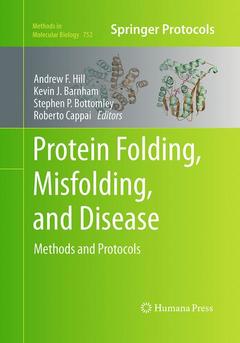Description
Protein Folding, Misfolding, and Disease, Softcover reprint of the original 1st ed. 2011
Methods and Protocols
Methods in Molecular Biology Series, Vol. 752
Coordinators: Hill Andrew F., Barnham Kevin J., Bottomley Stephen P., Cappai Roberto
Language: English
Subject for Protein Folding, Misfolding, and Disease:
Publication date: 08-2016
Support: Print on demand
Publication date: 07-2011
249 p. · 17.8x25.4 cm · Hardback
Description
/li>Contents
/li>Comment
/li>
Protein misfolding is a key feature of many disorders in humans, given that over twenty proteins are known to misfold and cause disease. In Protein Folding, Misfolding, and Disease: Methods and Protocols, experts in the field present a collection of current methods for studying the analysis of protein folding and misfolding, featuring strategies for expressing and refolding recombinant proteins which can then be utilized in subsequent experiments. This detailed volume also covers methods for analyzing the formation of amyloid, protocols for determining the size and structure of native and misfolded proteins, as well as specific examples of where misfolded proteins can be examined using state-of ?the-art technologies. Written in the highly successful Methods in Molecular Biology? series format, chapters contain introductions to their respective topics, lists of the necessary materials and reagents, step-by-step, readily reproducible laboratory protocols, and key tips on troubleshooting and avoiding known pitfalls.
Up to date and authoritative, Protein Folding, Misfolding, and Disease: Methods and Protocols offers researchers the tools necessary to move ahead in this vital field.
Strategies for Boosting the Accumulation of Correctly Folded Recombinant Proteins Expressed in Escherichia coli.- An Escherichia coli Cell-Free System for Recombinant Protein Synthesis on a Milligram Scale.- Synthesis of Peptide Sequences Derived from Fibril-Forming Proteins.- Refolding Your Protein with a Little Help from REFOLD.- Circular Dichroism and Its Use in Protein Folding Studies.- Distance Measurements by Continuous Wave EPR Spectroscopy to Monitor Protein Folding.- Solution-State Nuclear Magnetic Resonance Spectroscopy and Protein Folding.- Diagnostics for Amyloid Fibril Formation: Where to Begin.- Probing Protein Aggregation with Quartz Crystal Microbalances.- Dried and Hydrated X-Ray Scattering Analysis of Amyloid Fibrils.- Solid-State NMR of Amyloid Membrane Interactions.- Sedimentation Velocity Analysis of Amyloid Fibrils.- Transmission Electron Microscopy of Amyloid Fibrils.- Surface Plasmon Resonance Spectroscopy: A New Lead in Studying the Membrane Binding of Amyloidogenic Transthyretin.- Elucidating the Role of Metals in Alzheimer’s Disease through the Use of Surface Enhanced Laser Desorption / Ionisation Time-of-Flight Mass Spectrometry.
These books may interest you

Protein Misfolding 143.27 €



